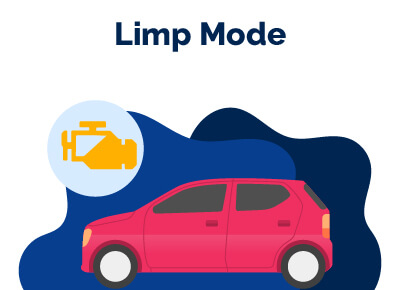Limp Mode Car (Everything You Need To Know)
June 11, 2023


Chris is Head of Content for FindTheBestCarPrice and is based out of Philadelphia, PA. As a seasoned automotive industry analyst and car enthusiast, he ensures the highest level of quality across all our content and curates our picks for the best deals each month.
Chris studied information systems and marketing at Drexel University and writes about a wide range of topics ranging from car buying tips to troubleshooting common mechanical issues.
When he’s not thinking about cars, he likes to stay in with his dog and make an “attempt” to finish a crossword puzzle (he’s not quite at the Saturday/Sunday level…yet). As a former cheesemonger, Chris still has a “sharp” passion for all things cheese, and his fridge is always loaded with it!
Chris also has a passion for things that go fast, and drones are no exception. He spends some of his time writing for Dronesourced.
Car maintenance can be hard, especially if you are not a mechanic or lack professional auto training. You’ll end up stumbling upon many terminologies you don’t understand and faults you don’t know how to fix.
If you are a regular driver, there’s a chance that you’ve heard about cars going into limp mode. In this situation, the vehicle will experience a loss of power in its engine, and no matter how hard you step on the gas pedals, the car wouldn’t drive any faster. The ‘check engine light’ will come on, and you’ll have no option but to pull your car over by the side of the road.
But what causes it? Loss of power in a car’s engine can mean many things. So, how do you know if your car is in limp mode? What causes a vehicle to go into limp mode, and how do you get your car out of limp mode?
Read on to learn all you need to know about a limp mode car and the effects it may have on your engine.
Table of Contents
What Is Limp Mode in a Car?
Limp mode is a default safety function built into your car to protect your car from further damage, especially when a fault is detected.
The limp mode is activated when your car’s engine and transmission control units decide that something is not wrong with your car.
So to prevent further damage, the system proceeds to shut down ‘less critical’ systems and components of your car, like the air conditioning, to limit your car’s performance, minimizing the risk of breaking down abruptly.
In this situation, power consumption is reduced, RPM is reduced, and enough power is channeled to the right sources sustaining your car until you can pull over or drive to the nearest auto shop.
The limp mode in a car is similar to when you sprain your ankle while playing basketball. You'll decide to limp home to limit the amount of pressure and pain on the injured leg. This is similar to when a car is in limp mode.
Your car is simply ‘limping home, protecting and reducing the damage on the vehicle until you reach your destination.
Limp Mode Car Causes
Why has my car gone into limp mode? Many factors can cause your car to go into limp mode. The reason for a limp mode in your car can range from easy to complicated depending on the factors influencing the situation.
Here are some of the common reasons why your car can get into limp mode;
1. Faulty Sensors
Faulty sensors remain one of the major causes of limp mode in your car. With the advancement of technology and its integration in cars, your car’s engines and transmission is controlled by sensors. These sensors send signals to your car’s computer to determine the state of things with the car.
However, like every other technological system, sensors are bound to fail or generate improper signals and errors. The position and function of the sensor will determine if it can send your car to limp mode.
There are a few sensors that can get your car into limp mode. These are sensors like; Mass airflow sensors, manifold absolute pressure sensors, throttle position sensors, speed sensors, etc.
Whenever these sensors malfunction or produce a bad reading, there’s a high chance that your car will go into limp mode. The problem with faulty sensors is that you might have difficulty figuring out which sensors went bad.
2. Boost Control and Pressure Problem
The boost control problem is synonymous with turbocharged cars. As you should know, Boost controls help regulate the pressure your car’s turbocharger creates.
In the event that there’s a problem with the boost control, it will trigger a boost leak or over-boost, which will, in turn, send your car into limp mode.
If your car gets an over-boost for a long period, your electronic control unit (ECU) will be affected. Extended use can damage your head gasket, and tamper with your fuel system, etc. Your car will be sent into limp mode to reserve power circulation across critical areas to prevent further damage.
There are quite a few factors that can cause an over-boost. An over-boost can result from problems with your turbochargers, wastegates, boost pressure sensors, and boost control valves. It can also happen when there’s a boost pipe leak.
3. Low Fluid Levels
Low fluid level is another major reason your car can go into limp mode. Oils are added to cars to aid lubrication, reduce friction levels and prevent the build-up of heat.
When your transmission fluid is low, there will be a drop in pressure, which can affect your transmission. Any malfunctioning in your transmission can trigger lots of effects on your ECU and send your car to limp mode.
4. Wiring Problems
Wiring problems like broken or damaged wires are major causes of car limp mode. There are many wires that run through your car.
As expected, there are wires that connect the transmission/engine with other components of the car. These wires help transmit signals that can send power to other parts of the car.
In the event that there is bad or broken wiring or loose connectors, your car will transmit bad signals, which will cause the car to get into limp mode.
The effect of bad wiring depends on the areas affected. If there is bad wiring in the boost control, the ECU can’t control boost pressure, and this will cause it to send the car into limp mode for the driver to effect changes immediately.
Just like there are numerous wires in your car, you might need help tracing the exact wires that are broken.
5. Transmission Faults
One of the reasons why your car is getting into limp mode is because you have a faulty transmission. The problem is usually not limited to the transmission but also the clutch.
Whether you are running on a bad solenoid, faulty sensors, issues on the control module, or even low transmission fluid level, your car will get into limp mode if it figures out any problem with the transmission.
6. Faulty Engines
Your car can get into limp mode if you have faulty engines or bad engine components. Sometimes, this can happen if you push your car’s engine too hard until it overheats.
Can You Drive a Car in Limp Mode?
Yes. You can drive a car in limp mode, but only for a limited time. You don’t need to drive a car in limp mode for too long to avoid complicating issues in your car. Whenever your car goes into limp mode, drive till you’re able to park and rectify the problem.
You must understand that when your car gets into limp mode, it is not trying to hinder you from getting to your preferred location. However, it is a plot to get you to address dangerous and grave situations before it becomes worse.
Will Driving in Limp Mode Damage Engine?
Yes. Driving a car in limp mode can damage your engine. However, this depends on the initial reason why the car went into limp mode.
If your car goes into limp mode because of overheating, there is a high chance that prolonged driving in the same state (limp mode) will damage the engine. Anytime you notice that your car is in limp mode, it is important that you pull over and rectify the issue before you continue driving.
Limp Mode Car Symptoms
Just as there are different reasons why your car will get into limp mode, there are different symptoms that can help you detect if your car has gotten into limp mode. These symptoms can even help you trace the actual cause of the limp mode.
Here are some of the common limp mode car symptoms:
- Check engine light comes on.
- Reduced speed, power, and acceleration.
- Poor engine performance.
- Some auxiliary functions are turned off.
- Limited gear functions.
Limp Mode Car Repair Cost
There isn’t a fixed limp mode repair cost. The cost of getting your car out of limp mode is dependent on the cause of the limp mode.
If you are lucky to notice that the reason for the limp mode is just a low fluid level, you might be spending as low as $100. This is compared to when you have problems with your turbocharger, which will cost as much as $3000.
How Do You Get Your Car Out of Limp Mode?
You might decide to get your hands dirty by trying to get your car out of limp mode. This can save you much cost but might not be advisable, especially if the problem requires much complexity.
Here are some easy ways to get your car out of limp mode.
- Check your fluid levels and refill.
- Rectify all sensor malfunctions, and clean or change bad sensors.
- Check the air filter and replace it if necessary.
- Get a scan tool/OBD reader and run a diagnosis on your car. Figure out the error codes and solve the problems.
Limp mode causes like bad wiring or overheating require professionalism. It is advisable that you hire a professional to avoid fixing problems that do not exist.
Conclusion
Limp mode is not the end of your car. It’s just an indication that you rectify whatever arising issues that are in your car. Whenever you spot a limp mode in your car, the best you can do is to pull over, drive to the nearest repair shop and get it fixed.
Best Car Deals by Category
Frequently Asked Questions
Can a weak battery cause limp mode?
Yes, but not in all scenarios. A weak battery can cause limp mode, especially if the battery is connected to your car’s computer. Even without being directly connected to the ECU, with a bad battery, your car’s sensors will get insufficient power which can either cause them to shut down or transmit wrong signals.
Can dirty oil cause limp mode?
Yes. Dirty oil can cause limp mode. Low fluid levels are not the only cause of limp mode; contaminants in the oil can also cause limp mode.
Posted in Car Buying Tips, Car Troubleshooting |




